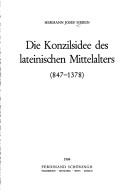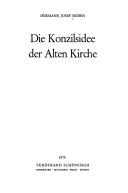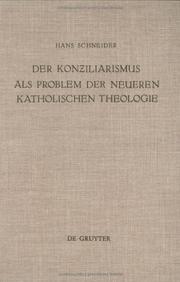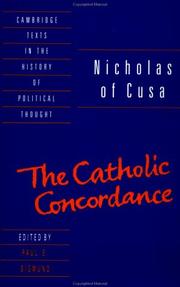Book
ISBN: 3534056558 9783534056552 Year: 1976 Volume: 279 Publisher: Darmstadt Wissenschaftliche Buchgesellschaft
Abstract | Keywords | Export | Availability | Bookmark
 Loading...
Loading...Choose an application
- Reference Manager
- EndNote
- RefWorks (Direct export to RefWorks)
Christian church history --- Ecclesiology --- Conciliar theory --- 260.3 --- -#GGSB: Ecclesiologie --- #GGSB: Kerk --- #GROL:SEMI-262.5 --- Conciliarism --- De Macht van de Kerk --- Addresses, essays, lectures --- Conciliar theory. --- Conciliar theory, Addresses, essays, lectures. --- Conciliarisme. --- William, --- 260.3 De Macht van de Kerk --- #GGSB: Ecclesiologie --- Ecclesiologie --- Kerk
Book
ISBN: 0860781372 Year: 1984 Publisher: London
Abstract | Keywords | Export | Availability | Bookmark
 Loading...
Loading...Choose an application
- Reference Manager
- EndNote
- RefWorks (Direct export to RefWorks)
Natural law --- History of the law --- anno 1200-1799 --- -Conciliar theory --- -Consent (Canon law) --- -Law, Medieval --- Medieval law --- Canon law --- Conciliarism --- Law of nature --- Natural rights --- Nature, Law of --- Rights, Natural --- Law --- History --- Conciliar theory --- Consent (Canon law) --- Law, Medieval. --- History. --- Law, Medieval

ISBN: 3506747223 9783506747228 Year: 1984 Publisher: Paderborn Schöningh
Abstract | Keywords | Export | Availability | Bookmark
 Loading...
Loading...Choose an application
- Reference Manager
- EndNote
- RefWorks (Direct export to RefWorks)
Christian church history --- anno 1200-1499 --- anno 800-1199 --- Conciliar theory --- History of doctrines --- 260.322.3 --- -#GROL:SEMI-262.5<09> Konz B --- 262.5 --- Conciliarism --- Concilies: leergezag. Conciliarisme --- -Oecumenische concilies:--algemeen --- 262.5 Oecumenische concilies:--algemeen --- Oecumenische concilies:--algemeen --- 260.322.3 Concilies: leergezag. Conciliarisme --- #GROL:SEMI-262.5<09> Konz B --- Conciliar theory - History of doctrines - Middle Ages, 600-1500 --- Conciles

ISBN: 3506747215 9783506747211 Year: 1979 Publisher: Paderborn: Schöningh,
Abstract | Keywords | Export | Availability | Bookmark
 Loading...
Loading...Choose an application
- Reference Manager
- EndNote
- RefWorks (Direct export to RefWorks)
Conciliar theory --- Councils and synods --- History --- -Councils and synods --- -#GOSA:II.P.AU.1 --- #GOSA:II.P.AU.3 --- #GOSA:II.P.Alg.M --- #GROL:SEMI-262.5<09> Konz B --- 262.5 --- Christian councils and synods --- Church councils --- Synods --- Religious gatherings --- Conciliarism --- Oecumenische concilies:--algemeen --- History. --- 262.5 Oecumenische concilies:--algemeen --- #GOSA:II.P.AU.1 --- Conciliar theory - History --- Councils and synods - History
Book
ISBN: 3782006100 9783782006101 Year: 1990 Volume: 37 Publisher: Frankfurt am Main Knecht
Abstract | Keywords | Export | Availability | Bookmark
 Loading...
Loading...Choose an application
- Reference Manager
- EndNote
- RefWorks (Direct export to RefWorks)
Conciliar theory --- Councils and synods --- History. --- 260.322.3 --- -Councils and synods --- -#GROL:SEMI-262.4 --- 262.4 --- Christian councils and synods --- Church councils --- Synods --- Religious gatherings --- Conciliarism --- Concilies: leergezag. Conciliarisme --- History --- Bisschoppensynodes. Bijzondere concilies --- 262.4 Bisschoppensynodes. Bijzondere concilies --- 260.322.3 Concilies: leergezag. Conciliarisme --- #GROL:SEMI-262.4 --- Conciliar theory - History. --- Councils and synods - History.

ISBN: 3110057441 311083961X 9783110057447 Year: 2011 Volume: 47 Publisher: Berlin ; Boston : De Gruyter,
Abstract | Keywords | Export | Availability | Bookmark
 Loading...
Loading...Choose an application
- Reference Manager
- EndNote
- RefWorks (Direct export to RefWorks)
Die seit 1925 erscheinenden Arbeiten zur Kirchengeschichte bilden eine der traditionsreichsten historischen Buchreihen im deutschsprachigen Raum. Sie enthalten Forschungen zur Kirchen- und Dogmengeschichte des Christentums aller Epochen, veröffentlichen aber auch Arbeiten aus verwandten Disziplinen wie beispielsweise der Archäologie, Kunstgeschichte oder Literaturwissenschaft. Kennzeichnend für die Reihe ist der durchgängige Anspruch, historisch-methodische Präzision mit systematischen Kontextualisierungen des jeweiligen Gegenstandes zu verbinden. In jüngerer Zeit erscheinen verstärkt Arbeiten zu Themen einer Kultur- und Ideengeschichte des Christentums in einem methodisch offenen christentumsgeschichtlichen Horizont.
260.322.3 --- -#GROL:SEMI-262.5 --- Conciliarism --- Concilies: leergezag. Conciliarisme --- 260.322.3 Concilies: leergezag. Conciliarisme --- Conciliar theory --- #GROL:SEMI-262.5 --- History of doctrines --- Council of Constance --- Concilio de Constanza --- Constanzer Concil --- Konstanzer Konzil --- Konzil von Konstanz --- Sněm kostnický --- Weliký sněm kostnický --- History of doctrines. --- Conciliar theory - History of doctrines
Book
ISBN: 3506788663 9783506788665 Year: 2018 Publisher: Paderborn Ferdinand Schöningh
Abstract | Keywords | Export | Availability | Bookmark
 Loading...
Loading...Choose an application
- Reference Manager
- EndNote
- RefWorks (Direct export to RefWorks)
Church history --- Conciliar theory. --- Schism, The Great Western, 1378-1417. --- Conrad, --- Schism, The Great Western, 1378-1417 --- Conciliar theory --- 260.322.3 --- Christianity --- Ecclesiastical history --- History, Church --- History, Ecclesiastical --- History --- 260.322.3 Concilies: leergezag. Conciliarisme --- Concilies: leergezag. Conciliarisme --- Conciliarism --- Great Schism --- Great Western Schism --- Papal Schism, 1378-1417 --- Western Schism --- Papacy --- Konrad, --- Schism, The Great Western (1378-1417) --- Konrad von Gelnhausen
Book
ISBN: 110892462X 9781108924627 9781108831796 9781108927192 1108934870 1108831796 110892395X Year: 2021 Publisher: Cambridge ; New York, NY Cambridge University Press
Abstract | Keywords | Export | Availability | Bookmark
 Loading...
Loading...Choose an application
- Reference Manager
- EndNote
- RefWorks (Direct export to RefWorks)
How was power justified in late medieval Europe? What justifications did people find convincing, and why? Based around the two key intellectual movements of the fifteenth century, conciliarism in the church and humanism, this study explores the justifications for the distribution of power and authority in fifteenth- and early sixteenth-century Europe. By examining the arguments that convinced people in this period, Joseph Canning demonstrates that it was almost universally assumed that power had to be justified but that there were fundamentally different kinds of justification employed. Against the background of juristic thought, Canning presents a new interpretative approach to the justifications of power through the lenses of conciliarism, humanism and law, throwing fresh light on our understanding of both conciliarists' ideas and the contribution of Italian Renaissance humanists.
Power (Social sciences) --- Law, Medieval --- Humanism --- Conciliar theory --- Authority --- History --- History. --- Empowerment (Social sciences) --- Political power --- Exchange theory (Sociology) --- Political science --- Social sciences --- Sociology --- Consensus (Social sciences) --- Authoritarianism --- Conciliarism --- Philosophy --- Classical education --- Classical philology --- Philosophical anthropology --- Renaissance --- Légitimité (science politique) --- Théorie conciliaire --- Humanisme de la Renaissance --- Influence. --- Légitimité (science politique) --- Théorie conciliaire

ISBN: 0521402077 0521567734 Year: 1991 Volume: vol *15 Publisher: Cambridge [England] New York Melbourne Cambridge University Press
Abstract | Keywords | Export | Availability | Bookmark
 Loading...
Loading...Choose an application
- Reference Manager
- EndNote
- RefWorks (Direct export to RefWorks)
Church and state --- Conciliar theory --- Political science --- Eglise et Etat --- Théorie conciliaire --- Science politique --- Catholic Church --- Early works to 1800. --- Philosophy --- Eglise catholique --- Ouvrages avant 1800 --- Philosophie --- -Conciliar theory --- -Conciliarism --- Christianity and state --- Separation of church and state --- State and church --- State, The --- -Early works to 1800 --- Early works to 1800 --- #A9703W --- -Church of Rome --- Roman Catholic Church --- Katholische Kirche --- Katolyt︠s︡ʹka t︠s︡erkva --- Römisch-Katholische Kirche --- Römische Kirche --- Ecclesia Catholica --- Eglise catholique-romaine --- Katolicheskai︠a︡ t︠s︡erkovʹ --- Chiesa cattolica --- Iglesia Católica --- Kościół Katolicki --- Katolicki Kościół --- Kościół Rzymskokatolicki --- Nihon Katorikku Kyōkai --- Katholikē Ekklēsia --- Gereja Katolik --- Kenesiyah ha-Ḳatolit --- Kanisa Katoliki --- כנסיה הקתולית --- כנסייה הקתולית --- 가톨릭교 --- 천주교 --- Government --- -Catholic Church --- -Government --- Théorie conciliaire --- Conciliarism --- Catholic Church&delete& --- Church and state - Catholic Church - Early works to 1800. --- Conciliar theory - Early works to 1800. --- Catholic Church - Government - Early works to 1800. --- Church of Rome
Book
ISBN: 3870882905 9783870882907 Year: 1982 Volume: 45 Publisher: Paderborn Bonifacius
Abstract | Keywords | Export | Availability | Bookmark
 Loading...
Loading...Choose an application
- Reference Manager
- EndNote
- RefWorks (Direct export to RefWorks)
Popes --- Conciliar theory --- Petrine office --- Primacy --- History of doctrines --- Leo --- Council of Ephesus --- Council of Chalcedon --- 262.131.1 --- -Petrine office --- -Popes --- -Conciliarism --- Holy See --- See, Holy --- Papacy --- Petrine function --- Petrine ministry --- Petrine primacy --- Church --- Papacy and Christian union --- Pausschap: voorrang van de stoel van Petrus --- -History of doctrines --- -Primacy --- -Apostolicity --- Leo I, Pope --- -Pausschap: voorrang van de stoel van Petrus --- -Leo I, Pope --- 262.131.1 Pausschap: voorrang van de stoel van Petrus --- -262.131.1 Pausschap: voorrang van de stoel van Petrus --- Conciliarism --- Apostolicity --- Leo I (Magnus) --- Latrocinium --- Robber Council --- Robber Synod --- Synode von Ephesus --- Chalcedon, Council of, --- Concilio di Calcedonia --- Konzil von Chalkedon --- Concilium Chalcedonense --- Léon --- Leo, --- Léon, --- Leon, --- Leone, --- Popes - Primacy - History of doctrines - Early church, ca 30-600 --- Conciliar theory - History of doctrines - Early church, ca 30-600 --- Petrine office - History of doctrines - Early church, ca 30-600 --- Leo - I, - Pope, - -461

 Search
Search Feedback
Feedback About UniCat
About UniCat  Help
Help News
News